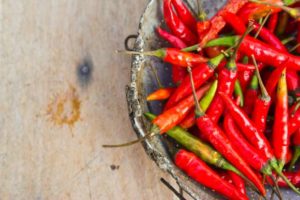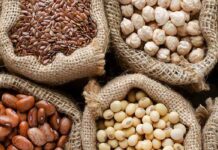The pungency of the chilly is due to capsaicin present in the membrane placenta.
To store and make the chilly powder more pungent, mix it well with oil.
The hottest chilly ‘Naga Jolokia’ in the world is found in Tezpur, India. It is 855,000 in Scoville Scale.
The chilly’s pungency is measured by Scoville scale which was named after Wilbur Scoville. With invention of computers, the pungency of chilly can be measured by HPLC.
To get rid of burning feeling, it is advisable to take fat or greasy content like milk, curd, sugar, or ice cream. Drinking water will not relieve the burning of your mouth because capsaicin is insoluble in water.
Medicinal Value
capsaicin is used for treatment for many diseases like arthritis.
When chilly is eaten, it makes the brain to release endorphins, a natural painkiller present in the body. The endorphin lowers blood pressure and helps to fight against cancer.
Chilly contains lots of vitamin A, vitamin B, and vitamin C
Sore throat, varicose ulcers, and laryngitis can be cured by using antibacterial chilly. Man made capsaicin called “Guafenesein” is used in cough syrups.
Chilly helps cure many diseases like blood pleasure, insomnia, hay fever, flu.
There are many varieties that are grown across India and some are mentioned below.
Kashmiri Chilli
Known more for its colour than its spice, this chilli is ground into a powder and used not only in Kashmiri dishes but in many dishes across the country and the world to add a beautiful red colour to the dish as well as enhance the dish’s taste. It’s so mild in its spiciness that it measures barely 2000 SHU (Scoville Heat Units). The Scoville Heat Scale measures the spiciness or the hotness of a chilli. The highest is Pure Capsaicin and Dihydrocapsaicin which measures 16,000,000 SHU. Now you can understand exactly how mild the Kashmiri Chilli is!!
Guntur Chilli
Andhra cuisine is famous for its extremely spicy dishes and the chilli responsible for this is the Guntur Sannam – S4. The Sannam chilli has many varieties that are grown not only in Andhra but also in states such as Madhya Pradesh. Known for its heat, unless one is used to such a high level of spiciness, you will find many people in tears when eating delicious Andhra dishes. As the name suggests, it’s grown extensively in this region. This chilli has become so popular; it is exported to all over the world. It accounts for roughly 30% of India’s chilli exports.
Bird’s Eye Chilli –Dhani
This is grown in the North East and is tiny but packs a punch in terms of spice. It is used not only in cooking but also used in chutneys and pickles. When eating a pickle made of these chillis, it is best to literally take half a teaspoon on your plate to begin with and to savour it by eating tiny portions of this quantity. That way your tears don’t flow in torrents!
Naga Chilli
They comprise of some varieties of chillis which are rank as some of the hottest chillis in the world. Supposedly the Indian Army wants to use some of the varieties of chillis as weapons! They are extremely hot that after eating it people have reported of eyes burning, leaky noses; people collapsing, vomiting and getting stomach cramps. Some have even retired to their beds for a day or two to recover from the effects!
Mundu Chilli
Grown in Tamil Nadu and Andhra, they are small & round with a thin skin. It has a very unique flavour. They are barely spicy but have a unique flavor which enhances the flavours of many dishes.
Jwala Chilli
Grown primarily in Gujarat, this chilli is grown all over the country and is used widely in India for cooking. Though its green initially, once it matures it turns red in colour. They can even be grown at home. It is one of the country’s most important crops.
Kanthari Chilli
These chillies are grown in Kerala and become white when mature. These chillis are hot and lend a good flavor to dishes. Kanthari chillies are a unique variety of Bird’s Eye Chilli. It is a perennial crop.
Byadagi Chilli
This chilli is grown in Karnataka. It is is long and has a thin skin, and when it’s dried has a crinkly appearance. It is known for its colour and pungency and is consumed across India. The Byadagi Chilli is similar to Paprika.
There are many more varieties which are produced across India and which are consumed in those regions. Chillies are integral to Indian cooking and most of us Indians have developed stomachs of steel having grown up eating chillies. Used in almost every dish, it’s a major commercial cash crop in our nation and though the chilli arrived in India only in the 16th century, it’s now become synonymous with our cuisine.








